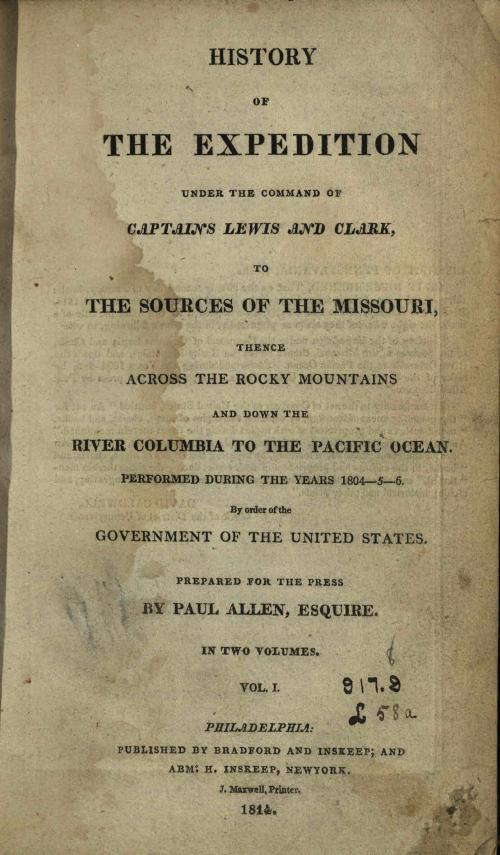A Succinct and Circumstantial Narrative: The Expedition of Lewis and Clark

On May 14, 1804, Meriwether Lewis and William Clark departed St. Louis for what would be a two year expedition across the new Louisiana Purchase, through the Continental Divide, and finally to the Pacific Ocean. In honor of the 212th anniversary of their journey, we would like to share the two-volume History of the Expedition Under the Command of Captains Lewis and Clark.
The story of this voyage is familiar to most of us. Thomas Jefferson’s recent acquisition of the Louisiana Territory, which ran north to south through the central third of the United States, fostered a desire to map the newly-acquired territory. Jefferson’s motivations went further: he hoped that explorers would discover a navigable route across the continent and establish an American presence before Great Britain or France gained a foothold in the area.
Both Lewis and Clark were natives of Virginia and former military members who had served in the U.S. Army, with Lewis rising to the rank of Captain and Clark being Second Lieutenant under his command. When Jefferson appointed Lewis to lead the voyage across the continent, it was Clark to whom he turned as he began recruiting party members. The men’s instructions: map a course to the Pacific (as described above); build diplomatic relations with the native nations of the west; and observe, collect, document and classify both their experiences and any artifacts that exemplified those experiences.

Because information on their journey is widely available via a variety of sources outside of Ohio Memory (which we will share at the end of this post), we won’t recap the two-year voyage here. However, we are thrilled to share their observations and notes via the recently-digitized History of the Expedition. It is loaded with daily notations on weather, geography, plants, animals, local cultures, and exciting stories. Though the interior and western portions of the United States were, of course, inhabited by native peoples, to these explorers it was entirely unknown. We can imagine their fear and their sense of wonder as they made what were, to them and to most other Anglo-Americans, brand-new discoveries. The two-volume set is quite lengthy, but it is organized like a diary and is written in language that is easy to follow. Our recommendation: choose a particular date, read the notes from that date, and then consider how your life differs from that which is described in that daily entry. Or think about how Lewis and Clark changed America by way of their exploration and reporting. No matter how you choose to use the History of the Expedition, we are sure that you’ll enjoy it tremendously!
For more information on the Lewis and Clark Expedition, visit the following:
- The Library of Congress: Rivers, Edens, Empires: Lewis & Clark and the Revealing of America
- The Lewis and Clark Fort Mandan Foundation: Discovering Lewis & Clark
- Yankton (South Dakota) Chamber of Commerce, Yankton Daily Press and Dakotan: Lewis & Clark’s Historic Trail
Thank you to Shannon Kupfer, Digital/Tangible Media Cataloger at theState Library of Ohio, for this week’s post!



Leave a Reply
You must be logged in to post a comment.